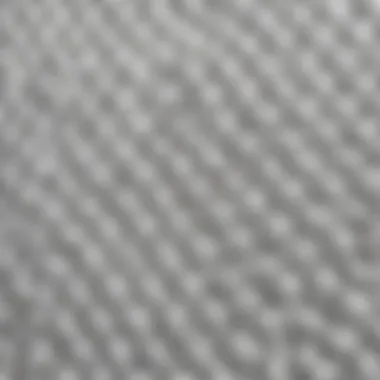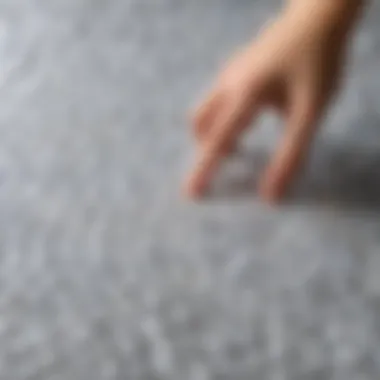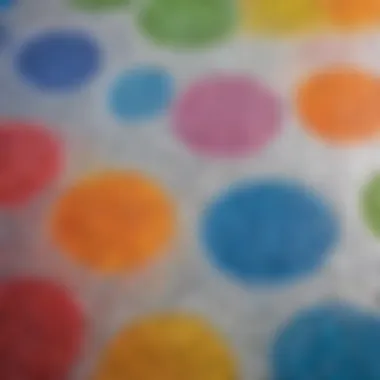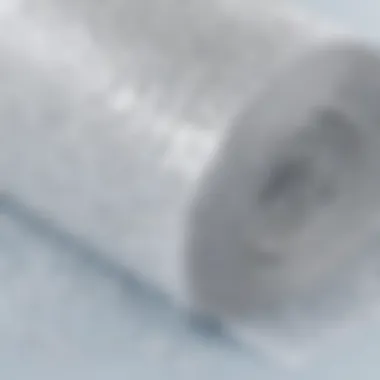Exploring Bubble Wrap Printing: Functionality Meets Artistry


Intro
Bubble wrap is commonly recognized for its essential role in protecting delicate items during shipping. However, this seemingly ordinary material possesses hidden artistic applications that often go unnoticed. The exploration of bubble wrap printing reveals a unique intersection between functionality and art, where practicality meets creativity. This article guides readers through the history of bubble wrap printing, its methods, potential for artistic expression, and environmental implications.
Understanding these different facets encourages curiosity in science as a whole, showing how materials can hold deeper significance.
Science Fun Facts
When engaging with the concept of bubble wrap printing, there are numerous facts that can surprise and intrigue learners.
Interesting Trivia and Facts
- First Use: Bubble wrap was invented in 1957 by engineers Alfred Fielding and Marc Chavannes. Originally, they intended to use it as wallpaper.
- Protection Power: The air-filled bubbles create a cushioning effect, making it one of the most effective packaging materials against shock and vibration.
- Artistic Use: Many artists and students make use of bubble wrap to create prints known as
Intro to Bubble Wrap Printing
Bubble wrap has become synonymous with protection in shipping and storage, but it carries further potential as an artistic medium. In exploring bubble wrap printing, we step into an amalgamation of functionality and creativity. This form of printing offers significant educational opportunities for young science enthusiasts while showcasing the aesthetic qualities which bubble wrap can present.
Understanding the relevance of bubble wrap printing illuminates its wide appeal. Firstly, it plays a role in introducing basic concepts of printing and craftsmanship.
Moreover, utilizing bubble wrap for printing helps establish connections between science and art. The material's inherent properties can teach children about mechanics, material science, and creativity. With each bubble serving not only a practical function but also as a canvas, the possibilities prove engaging and multifaceted.
For example, techniques involving color use and texture layering enable us to explore artistic effects. Young individuals gain insights into color theory and experimentation, pushing boundaries on what can be expressed through simple materials. Educators can further expand these lessons by incorporating hands-on activities that foster analysis, problem-solving, and inventiveness.
Here are some primary considerations about bubble wrap printing that resonate strongly within this exploration:
- Enhances focus on creativity through practical application of basic scientific principles.
- Simplifies complex ideas of printing and design that are accessible to younger audiences.
- Encourages exploration of pressing environmental questions.
- Promotes skill-building, enhancing motor abilities while understanding material utility.
Bubble wrap printing combines creativity with education, making learning more enjoyable and impactful.
In summary, addressing bubble wrap printing allows us to uncover not just a means for expression but a unique pedagogical tool for schools and home activities. As we delve deeper into history, material science, and environmental implications, we discover that bubble wrap printing is more than just fun—it's an insightful journey connecting children, adults, and the broader world of art and science.
History of Bubble Wrap
The history of bubble wrap is not just an origin story but a fascinating timeline that highlights innovation and adaptability. Understanding this history provides essential context for the significance of bubble wrap both as a material and a medium for artistic expression. Though primarily identified as a packaging necessity, bubble wrap’s unusual evolution into an art tool is a showcase of creative repurposing.
The Invention Story
Bubble wrap was born in the year 1960, crafted by engineers Alfred W. Fielding and Marc Chavannes in a quest to create a novel type of textured wallpaper. The initial purpose was purely decorative. However, the unique structure of trapped air within its plastic encapsulations caught the attention of the packaging industry. Sounds of texture and resilience emerged, and the material quickly shifted from aesthetics to functionality. This pivot from a mere surface design to a dynamic protective aid is a clear sign of the malleability of innovation. Therefore, what started as a wallpaper soon became the foremost option for safe packaging, reflecting not only a shift in intended use but also a broader narrative of adaptability in design.
Evolution of Use
As barer of importance in the shipping sector, bubble wrap evolved extensively over the years. During the early 1960s, its main attributes began to shine, helping professionals cushion fragile items from the inevitabilities of a rough journey.
By the 1980s, bubble wrap was recognized not just for its protective capabilities but also for its unusual qualities in creative applications. Art educators and parties from all classes began exploring bubble wrap’s potential in projects ranging from fun crafts to educational tools, using its vibrant colors and interesting textures.
Distinct Benefits:
- Provides effective protection against shocks and vibrations during shipping.
- Serves as an engaging medium for creativity among young learners.
Thence, bubble wrap has remained a staple material with boundless utility. This remarkable journey encapsulates the innovative spirit that those in the packaging and art industries so eagerly embrace. Not merely a byproduct of design, bubble wrap schanges itself constantly transport it into new realms—including the crucial intersection of science and art, demonstrating its compelling history and future potential.
Understanding Bubble Wrap Structure
Understanding the structure of bubble wrap is essential in grasping how this material serves both functional and artistic purposes. The unique design of bubble wrap connects its physical characteristics to both packaging usability and creative versatility. Recognizing how the material is constructed can shed light on its applications, advantages, and limitations as well.
Material Composition


Bubble wrap is primarily composed of polyethylene, which is a type of plastic. This material choice plays a crucial role in bubble wrap's lightweight nature and its durability. Beyond polyethylene, manufacturers sometimes incorporate other additives to enhance properties like UV resistance. The bubbles themselves are formed by air being trapped between two sheets of polyethylene, resulting in that recognizable cushioning effect.
Each layer that creates the bubbles adds strength. This structure makes bubble wrap a favored option in shipping and packaging. It's the balance between lightness and strength that keeps goods safe during transit. The flexibility of bubble wrap allows it to conform to the shape of various items, creating a snug protective wrap.
Properties of the Material:
- Lightweight: Easy to handle and can lower shipping costs.
- Durable: Resistant to most chemicals and degradation from sunlight, when specifically formulated.
Physical Properties
The physical properties of bubble wrap are relevant to its utility. The cushioning effect is certainly its most recognized attribute. Each bubble acts as a small cushion, distributing impact and preventing damage from shocks or drops. This is why bubble wrap is often the material of choice in industries where fragile items are commonplace, like in the electronics and art sectors.
Key Physical Properties:
- Shock Absorption: Bubbles absorb the energy from impacts which lessen the risk of damage.
- Thermal Insulation: Though not primarily designed for thermal control, it can help insulate items against temperature changes.
- Moisture Resistance: While not water-resistant, it can provide some barriers against moisture, protecting items stored in less-than-ideal conditions.
The unique structure of bubble wrap is the conduit for its multi-faceted applications, from protecting goods to serving as a medium for artistic expression.
This dual utility emphasizes understanding the structure is not merely academic but is intertwined with real-life applications in everyday scenarios.
Bubble Wrap as a Packaging Material
Bubble wrap celebrates its importance as a packaging material by delivering both functionality and creativity. This section explores its broad advantages in shipping while addressing notable limitations that can come with its use. Understanding these dynamics helps us appreciate why bubble wrap remains a staple in packaging solutions.
Benefits in Shipping
Bubble wrap provides significant advantages when used in shipping. First, it offers a high level of protection for fragile items. The air-filled bubbles create a cushion that absorbs shocks and vibrations during transport. This durability is essential for protecting delicate merchandise like ceramics and glassware.
Moreover, bubble wrap allows for versatility in packaging. It can conform to the shapes of objects, thus preventing movement within boxes. This minimization reduces the risk of breakage that can occur if items shift during shipment.
Another point to consider is its lightweight nature. Using bubble wrap keeps the overall weight of packages lower. This characteristic can lead to cost savings when shipping is calculated based on weight. Thus, small packages that need safe transit can still stay affordable.
Here are a few noteworthy benefits of using bubble wrap for shipping:
- Protection of fragile goods
- Versatility in adapting to different shapes
- Lightweight, reducing shipping costs
- Added layer of moisture protection
Bubble wrap has been essential for numerous industries seeking safe and reliable transportation for their products.
Limitations and Challenges
Despite its advantages, bubble wrap does have limitations and challenges. One of the primary issues is that it is made from plastic, leading to environmental concerns. Its widespread use contributes to plastic waste unless proper disposal or recycling practices are observed. The dilemma of balancing the need for packaging protection and minimizing waste presents a challenging scenario.
Additionally, bubble wrap is often ineffective with sharp objects. If a sharp item penetrates the bubbles, it may compromise the form of protection. Slippery or heavy items may also require additional protective materials when using bubble wrap to ensure they do not shift during transit.
Finally, not all bubble wrap is created equal. The sizes and thickness of bubbles vary, so low-quality bubble wrap may not provide adequate cushioning and lead to costly damages.
Consider these limitations and challenges when assessing bubble wrap for your shipping needs:
- Environmental concerns due to plastic use
- Vulnerability to sharp items or heavy loads
- Variability in quality, impacting protection
Examining these aspects adds depth to our understanding of bubble wrap, showcasing how it remains both a practical and contentious option in packaging. In the following sections, we will continue to investigate the printing techniques and artistic uses of this interesting material.
Techniques of Bubble Wrap Printing
Bubble wrap printing combines creativity and practicality. In this section, we explore its various techniques that make it unique. These methods are important for understanding how functionality meets artistic expression. Printing on bubble wrap is not just about embellishment; it can also serve educational and innovative purposes. This offers an engaging way for science enthusiasts, especially young students, to experiment with materials.


Basic Printing Processes
Basic printing processes involve straightforward methods that are accessible to many. One common approach is the use of stamps. Artists can create shapes and patterns by applying ink to a bubble wrap surface and then pressing it onto paper or fabric. This method encourages experimentation and is suitable for various educational projects.
Simple Steps for Basic Printing:
- Choose your design: Begin by planning the design you wish to create.
- Select your ink: Water-based inks work well as they are safe for younger users.
- Prepare the surface: Apply the ink on bubble wrap with either a brayer, foam brush, or simply using your hands.
- Print: Place the bubble wrap ink-side down on the desired surface. Press down evenly to transfer the image carefully.
Advanced Printing Technologies
Advanced printing techniques in bubble wrap utilize technology to produce higher quality images and allow for more complex designs. One cutting-edge method is digital printing. It employs computer software to create intricate prints on bubble wrap.
Here, the process becomes more technical. Digital printers can efficiently create detailed graphics for professional art installations or products for marketing. This showcases bubble wrap as not just packaging material, but as a canvas in its own right.
Advantages of Advanced Technologies:
- Quality: High-resolution prints achieve truly spectacular visual effects.
- Versatility: Expanded artistic possibilities due to large format capabilities.
- Customization: Artificial intelligence can predict color schemes and designs based on previous trends, offering customized finished products.
The significant advancement in printing has transformed bubble wrap from mere cushioning into a medium for vibrant and expressive art, paving the way for future creatives to explore its boundary-less potential and functionality.
Overall, exploring these printing techniques illustrates how bubble wrap serves as a bridge between utility and creativity. Each process, whether basic or advanced, unlocks potential for various applications.
Artistic Applications of Bubble Wrap Printing
Bubble wrap printing expands the possibilities for creative expression while rooted in functionality. This section uncovers the importance of the artistic aspects, offering insight into its unique benefits and considerations in the realm of both education and professional art. The interplay between functionality and aesthetic is highly significant, making it a compelling discussion point for students, educators, and artists alike.
Educational Projects and Crafts
Educational projects utilizing bubble wrap printing provide engaging hands-on learning experiences. Students discover concepts like texture, pattern, and color mixing. Using simple tools such as paint and rollers, they can create designs on the bubble surface. This not only fosters their artistic skills but also enhances their understanding of various printing techniques.
- Benefits of Using Bubble Wrap in Education:
- Inexpensive Materials: Bubble wrap is accessible and often discarded after use, promoting sustainability in crafts.
- Interactive Learning: Students actively participate in art, keeping them engaged and encouraging creativity.
- STEM Integration: Teachers can meld art with principles from science and math, like geometry in patterns and color theory.
Projects can range from creating colorful gift wrap to printing designs on fabric. This versatility applies not only for art but also for educational settings, where combining subjects enriches the learning experience.
An example project might include using bubble wrap to create seasonal greeting cards, where students immerse themselves in art while developing fine motor skills. Thus, bubble wrap printing acts as a bridge, connecting creativity with cognitive development, a vital aspect often overlooked in simple creativity.
Professional Art Installations
Although often associated with everyday shipping needs, bubble wrap has made its way into professional art installations. Artists direction new meanings from this familiar material, using it to convey concepts or evoke emotions in audiences. The prints created can add dimension and texture to the artworks, resulting in interesting layered effects.
- Significant Reasons Artists Choose Bubble Wrap:
- Unique Texture: Printers appreciate its three-dimensionality, adding depth to artwork.
- Adaptive Use in Environments: Its lightness allows for large installations almost anywhere, making it a desirable choice for contemporary art.
- Dialogue on Consumerism: Given bubble wrap's origins in commercial packaging, many artists comment on modern consumer habits and sustainability through their work, prompting viewers to reflect on their relationships with everyday objects.
A pronounced example includes installations that explore environmental themes by using remnant bubble wrap, intentionally conveying a message about waste and recycling. Engaging audiences effectively changes their perception of an ordinary object, elevating it to a high art medium.
Bubble wrap’s integration into the art realm opens discussions on functionality tied to creativity, stimulating interest in decluttering the notion that art must come solely from high-end materials. Like any artistic endeavor, the techniques may vary, but the results unveil how creativity can emerge from anywhere, challenging norms.
Success in using bubble wrap as an art form goes beyond creating an attractive piece. It entails fostering conversations surrounding sustainability and texture in artwork.
Environmental Impact of Bubble Wrap


The environmental ramifications of using bubble wrap have garnered significant attention in recent decades. As a material meant primarily for protection during shipping, bubble wrap's longevity presents both benefits and drawbacks regarding waste management and sustainability. Exploring these facets allows us to better understand how bubble wrap printing fits into the larger narrative of environmental responsibility.
Recyclability and Waste Management
Bubble wrap is often perceived as single-use plastic. However, it is recyclable. Many recycling centers accept it. To recycle properly, one should follow these steps:
- Clean the bubble wrap of any debris.
- Separate it from other types of plastic materials.
- Take it to designated recycling drop-off points or check if local services pick it up
Despite these measures, challenges remain. Many localities do not have stringent recycling processes or facilities equipped to handle bubble wrap specifically. This often leads to more bubble wrap ending up in landfills than necessary.
In educational settings, understanding waste management is crucial. Young science enthusiasts can discover practical ways to manage bubble wrap responsibly through interactive projects. Insights gained from such experiences equip students with skills for introspection on the materials they consume and dispose of.
Sustainable Alternatives
The search for sustainable wrapping solutions shows the growing awareness of environmental impact. Some reasonable alternatives to traditional bubble wrap come to light. Among them are:
- Mushroom Packaging: Made from agricultural by-products, this option is entirely biodegradable.
- Paper-Based Padding: Not only provides good protection, but it is also easily recyclable.
- Recycled Cotton Padding: Eco-friendly and sustainable, made from rebundled fabric scraps.
As technology develops, so does the potential for new materials that offer the same robustness as bubble wrap but with less environmental footprint. Schools and parents can encourage experimentation with these alternatives. By doing so, children can better grasp concepts related to renewable resources and eco-friendly consciousness.
The future lies in a vast expanse of possibilities—one where creativity meets sustainability.
Future of Bubble Wrap Printing
The future of bubble wrap printing holds significant importance as we navigate a world increasingly concerned with sustainability, innovation, and creative expression. In this section, we will explore innovative developments and market trends that shape the future landscape of this unique print medium. Understanding these facets is crucial for educators, aspiring artists, and curious young minds as they embrace the possibilities this material offers.
Innovative Developments
Innovative developments in bubble wrap printing are elevating its role beyond mere packing material. This not only indicates advancements in printing technology, but also showcases creative potential that appeals to designers and artists alike. For example, new methods of applying inks that promote longevity and vibrant colors have been discovered. This improvement ensures that bubble wrap can serve both practical purposes and as a canvas for art.
Moreover, environmentally friendly inks are becoming more common, aligning with a global push towards reducing carbon footprints. These inks help support artistic processes without harming the environment. Companies are investing in research on biodegradable bubble wrap as well, thus making the product a sustainable choice.
The emergence of 3D printing techniques also intertwines with bubble wrap. Artists can not only print images but also create three-dimensional sculptures using this lightweight medium. This layer of complexity invites more educational projects and school experiments, fostering curiosity and creativity among children.
Innovations are crucial to ensuring that artists of all ages can express themselves while remaining considerate of the environment.
Market Trends
Market trends surrounding bubble wrap printing highlight a growing interest in recreational and educational purposes. The trend reflects the broader market dynamics in art materials, with investment flowing into sustainable products. As parents and educators alike search for ways to integrate creativity in practical scenarios, bubble wrap offers a multifaceted solution.
Its role in educational settings cannot be understated. Schools are adapting their art programs to embrace unconventional materials like bubble wrap, introducing students to mixed-media projects in a fun and accessible way. Young artists often revel in the hands-on experience of printing and crafting with bubble wrap, transforming a packaging material into artistic expression.
As interest from consumers increases, businesses are responding with a wider array of colors and textures for printed bubble wrap. Customization is another key trend, allowing anyone to design unique prints for specific events or purposes. This boom in products signals exciting possibilities in both personal and commercial spheres.
Understanding these emerging patterns can enable active participants in the market—be it consumers, artists, or educators—to engage with bubble wrap on a new level. Learning about the trends ultimately promotes exposure to new ideas and collaborations between technology and art.
Ending and Reflection
The various activities outlined highlight critical educational principles. Children become not only artists but also budding scientists. Practical endeavors build a bridge between artistic and scientific understanding, transforming an ordinary material into an extraordinary learning opportunity. With such unique applications, exciting future developments are bound to emerge.
End and Reflection
The section on conclusion and reflection serves as a critical culmination of the insights discussed throughout the article. It reinforces the significance of bubble wrap printing, not just from a technical standpoint, but also in terms of creativity and sustainability. Understanding each layer of bubble wrap, from its structure to its uses, deepens appreciation for its role in both packaging and art. This reflection also highlights challenges, like environmental concerns that can arise with extended use. These elements encourage readers to think critically about the materials they interact with daily.
Key Takeaways
- Versatility: Bubble wrap is not only effective in packaging goods safely but also serves as a unique medium for artistic expression.
- Sustainability: Recycling options exist, and with proper disposal, the ecological impact can be minimized.
- Creativity: Engaging with bubble wrap in art projects broadens understanding of materials and nurtures inventive thinking in children.
Encouragement for Exploration
Though bubble wrap is commonly seen as a mundane packing material, its potential extends far and wide. Encourage young science buddies to experiment with different techniques in bubble wrap printing. They can explore various inks, shapes, and create their design projects. This process fosters creativity while also offering a hands-on understanding of the science behind printing. It might initiate an appreciation for how everyday objects can enrich both learning and art. Try introducing bubble wrap crafting in workshops or activities, where young enthusiasts could share their innovative projects. Exploring bubble wrap goes beyond mere fun; it can spark a lifelong interest in both art and science. Moreover, sharing discoveries with peers enhances teamwork and communication skills. By nurturing a sense of curiosity, children can evolve into thoughtful creators who recognize the value in both aesthetics and functionality.







